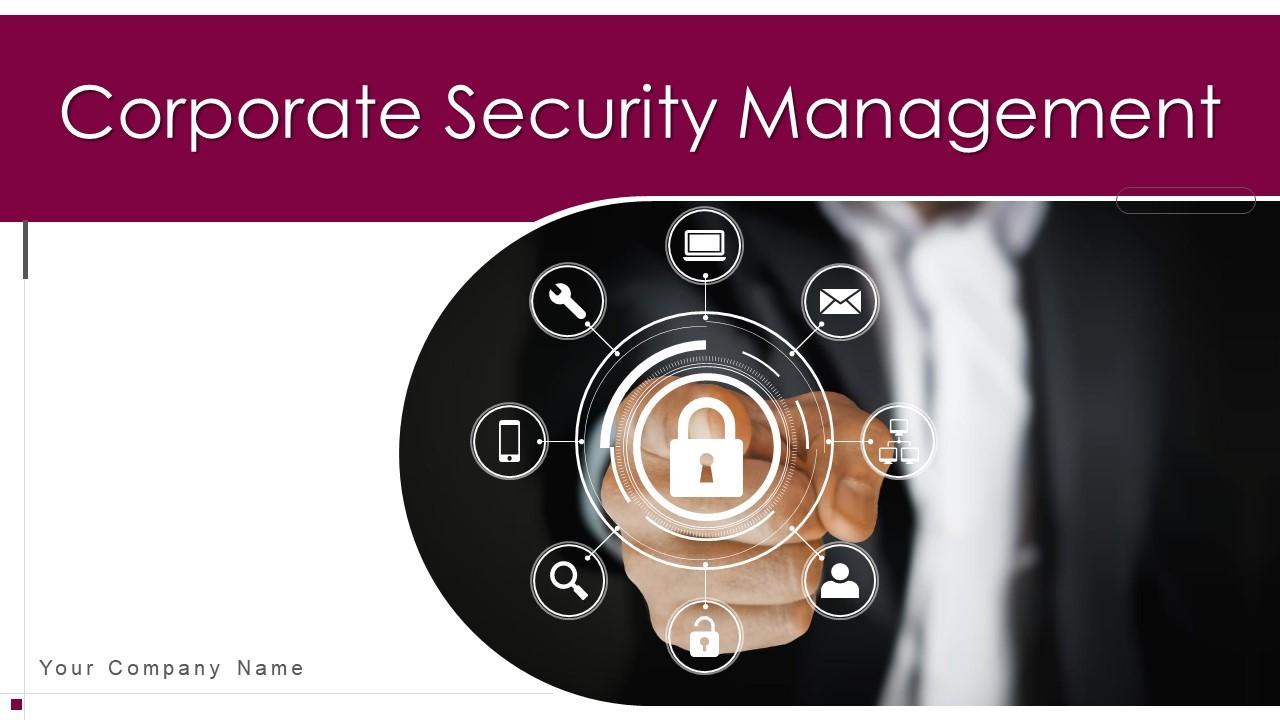Empowering Your Organization with Ironclad Corporate Security Actions
Empowering Your Organization with Ironclad Corporate Security Actions
Blog Article
From Cybersecurity to Physical Actions: Enhancing Business Protection in an Altering Globe
In today's quickly advancing electronic landscape, the importance of business security can not be overstated. As cyber hazards end up being significantly advanced and common, organizations have to surpass standard cybersecurity steps to secure their assets and procedures - corporate security. This is where the assimilation of physical safety and security measures ends up being crucial. By integrating the toughness of both cybersecurity and physical safety and security, companies can develop an extensive protection strategy that attends to the varied variety of dangers they encounter. In this conversation, we will explore the altering danger landscape, the demand to incorporate cybersecurity and physical security, the application of multi-factor authentication procedures, the relevance of worker awareness and training, and the adaptation of safety and security steps for remote workforces. By taking a look at these crucial locations, we will certainly gain beneficial understandings right into just how companies can strengthen their corporate safety and security in an ever-changing world.
Comprehending the Transforming Hazard Landscape
The progressing nature of the contemporary globe necessitates a comprehensive understanding of the transforming risk landscape for effective company protection. In today's interconnected and electronic age, dangers to company safety and security have become much more intricate and advanced. As technology advances and organizations end up being progressively dependent on electronic facilities, the potential for cyberattacks, data violations, and various other safety violations has significantly boosted. It is essential for organizations to stay notified and adjust their safety and security determines to address these advancing risks.
One key element of understanding the changing risk landscape is identifying the various sorts of risks that organizations deal with. Cybercriminals are frequently developing brand-new strategies to exploit susceptabilities in computer system systems and networks. These dangers can range from malware and ransomware assaults to phishing rip-offs and social design methods. Additionally, physical dangers such as burglary, vandalism, and business reconnaissance remain prevalent concerns for companies.
Monitoring and examining the risk landscape is vital in order to determine prospective dangers and vulnerabilities. This involves remaining updated on the current cybersecurity patterns, analyzing hazard intelligence reports, and conducting normal danger assessments. By understanding the altering risk landscape, companies can proactively carry out suitable security procedures to reduce risks and protect their possessions, online reputation, and stakeholders.
Integrating Cybersecurity and Physical Protection
Integrating cybersecurity and physical security is critical for comprehensive business protection in today's digital and interconnected landscape. As organizations significantly depend on technology and interconnected systems, the limits in between physical and cyber dangers are becoming obscured. To effectively safeguard versus these risks, an alternative approach that incorporates both cybersecurity and physical protection steps is crucial.
Cybersecurity focuses on shielding electronic properties, such as information, systems, and networks, from unauthorized gain access to, disturbance, and theft. Physical protection, on the other hand, encompasses procedures to secure physical possessions, individuals, and centers from threats and susceptabilities. By integrating these two domain names, organizations can deal with vulnerabilities and dangers from both electronic and physical angles, thereby enhancing their general security position.
The combination of these 2 techniques enables a more detailed understanding of protection threats and enables a unified reaction to occurrences. For instance, physical gain access to controls can be enhanced by integrating them with cybersecurity protocols, such as two-factor authentication or biometric recognition. Similarly, cybersecurity steps can be matched by physical safety procedures, such as security electronic cameras, alarm systems, and secure access points.

Executing Multi-Factor Verification Measures
As organizations progressively focus on extensive safety steps, one reliable approach is the application of multi-factor verification measures. Multi-factor authentication (MFA) is a safety and security technique that calls for individuals to supply multiple forms of identification to access a system or application. This technique adds an additional layer of defense by combining something the user recognizes, such as a password, with something they have, like a fingerprint or a safety token.
By implementing MFA, companies can significantly enhance their safety and security stance - corporate security. Typical password-based verification has its limitations, as passwords can be easily compromised or failed to remember. MFA reduces these threats by adding an additional authentication element, making it much more tough for unapproved people to obtain accessibility to delicate information
There are a number of sorts of multi-factor authentication techniques available, including biometric authentication, SMS-based verification codes, and equipment symbols. Organizations require to examine their certain demands and select one of the most appropriate MFA solution for their demands.
Nonetheless, the execution of MFA must be meticulously intended and implemented. It is vital to strike a balance between safety and security and usability to stop customer disappointment and resistance. Organizations ought to also take into consideration prospective compatibility concerns and offer appropriate training and support to ensure a smooth shift.
Enhancing Staff Member Understanding and Training
To reinforce company security, companies should prioritize boosting staff member understanding and my company training. Lots of security breaches occur due to human error or absence of recognition.
Reliable employee recognition and training programs ought to cover a large array of subjects, consisting of information protection, phishing attacks, social engineering, password hygiene, and physical safety and security actions. These programs should be tailored to the specific needs and responsibilities of different worker functions within the organization. Routine training workshops, sessions, and simulations can aid staff members create the essential abilities and expertise to respond and identify to safety hazards properly.
Additionally, organizations ought to encourage a society of safety awareness and give recurring updates and pointers to maintain workers notified regarding the current threats and reduction techniques. This can be done through inner interaction networks, such as newsletters, intranet portals, and e-mail campaigns. By fostering a security-conscious labor force, organizations can dramatically lower the likelihood of security occurrences and shield their useful properties from unauthorized accessibility or compromise.

Adapting Security Steps for Remote Labor Force
Adjusting business safety actions to suit a remote workforce is vital in making sure the defense of sensitive info and properties (corporate security). With the enhancing pattern of remote work, companies have to implement suitable safety procedures to alleviate the dangers connected with this brand-new means of functioning
One essential aspect of adapting protection measures for remote job is developing safe and secure interaction channels. Encrypted messaging systems and digital exclusive networks (VPNs) can aid secure delicate info and stop unauthorized gain access to. Additionally, organizations should enforce the use of solid passwords and multi-factor verification to boost the protection of remote gain access to.
One more essential factor to consider is the implementation of secure remote accessibility services. This involves offering employees with safe accessibility to corporate resources and information via digital desktop infrastructure (VDI), remote desktop computer methods (RDP), or cloud-based options. These technologies guarantee that delicate details continues to be safeguarded while making it possible for workers to perform their duties successfully.

Finally, thorough protection awareness training is crucial for remote workers. Training sessions must cover best techniques for safely accessing and handling sensitive info, identifying and reporting phishing efforts, and maintaining the general cybersecurity health.
Verdict
In conclusion, as the threat landscape continues to evolve, it is critical for companies to enhance their security gauges both in the cyber and physical domain names. Integrating cybersecurity and physical safety and security, carrying out multi-factor authentication steps, and enhancing staff member understanding and training are vital actions towards achieving durable business protection.
In this conversation, we will certainly discover the changing hazard landscape, the requirement to incorporate cybersecurity and physical safety, the execution of multi-factor verification steps, the relevance of worker awareness and training, and the adjustment of site web safety and security actions for remote workforces. Cybersecurity actions can be matched by physical protection measures, such as security video cameras, alarm systems, and secure gain access to factors.
As organizations progressively focus on extensive safety measures, one effective approach is the application of multi-factor verification measures.In final thought, as the danger landscape continues to develop, it is crucial for organizations to enhance their protection measures both in the cyber and physical domains. Incorporating cybersecurity and physical protection, implementing multi-factor authentication procedures, and boosting employee awareness and training are important actions in the direction of achieving durable company protection.
Report this page